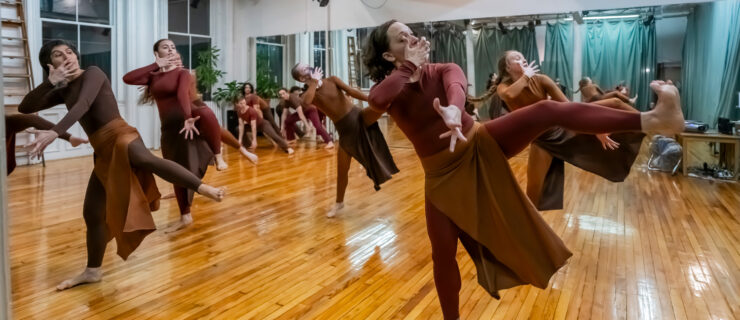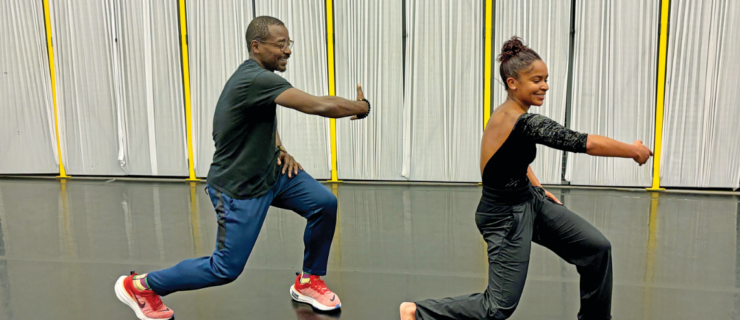Meet The Movement Coach Who Helped Rami Malek Transform Into Freddie Mercury
Watching Bohemian Rhapsody through the eyes of dancer, there’s a certain element of the movie that’s impossible to ignore: Rami Malek’s physical performance of Freddie Mercury. The way he so completely embodies the nuances of the rock star is simply mind-blowing. We had to learn how he did it, so we called up Polly Bennett, the movement director who coached him through the entire process.
In a bit of serendipitous timing, while we were on the phone, she got a text from Malek that he had just been nominated for a Golden Globe. And during our chat, it became quite clear that she had obviously been a major part of that—more than we could have ever imagined.
What Exactly Is a Movement Director?
Although the profession seems to be more common in the UK than in the US, movement direction is the oversight of the “physical life” of productions, says Bennett.
“It can expand from things like actual choreography and scene changes and character work—if someone’s playing something far away from them like a pregnant or disabled character—to working with the actors on character choices and identity tricks,” she says. Bennett has worked as a movement director on everything from productions by the Royal Shakespeare Company to plays on the West End to TV shows like “The Crown.”
How Movement Direction Differs from Choreography
Working with actors rather than dancers, a movement director’s primary goal is to enable performers to do what’s asked of them, rather than just setting movement phrases.
“You’re creating a dialogue between the actor and their character, so it’s a lot of research about the world in which the story is told,” says Bennett. That includes everything from the temperature of the place to the rhythm of life there to what it’s like to walk on that landscape. “You have to be able to offer information to the actors so that their imagination goes wild.”
The Biggest Challenge on Bohemian Rhapsody
Bennett was brought on to coach Malek just after he was offered the part of Freddie Mercury. “I had to find out ways to make this impossible task possible for an actor with very limited experience in movement,” she says. “Everyone says Freddie Mercury was the world’s greatest performer—that can ruin an actor’s imagination. Because how can you actualize that? That’s not a very helpful thought.”
To make it happen, Bennett set to work investigating why Mercury moved the way he did so that Malek’s movement could be spontaneous, not choreographed. She found out biographical details: Mercury had been a boxer growing up, he was an excellent long distance runner and enjoyed playing golf. “I could work with Rami to get him to run for a long time, get him to box, get himself limber and agile and able to change direction very quickly like a boxer does,” she says. “That way he could use his body as if he’d lived in Freddie’s body for 30 to 40 years.”
The film covers a span of 16 years, so Bennett and Malek also had to investigate how Mercury’s movements changed over time. “Freddie’s discovery of being a gay man means his relationship to people changed,” explains Bennett. “You look at him in the ’70s and his movements are quite flaunted and pose-y, then you look at him in 1985 where he’s really grounded into the floor, and very, very athletic.”
What It Was Like Re-creating that Iconic Live Aid Concert
The film ends with Queen’s 21-minute set at Live Aid in 1985, which might be one of the most famous rock performances of all time. The producers wanted to create an exact replica, a task that Bennett says was “mental.”
That’s because she had to identify and articulate to Malek every time Mercury turned his head, stepped over the microphone, clapped his hands, made eye contact with a band member, wiped his forehead—none of it on particular counts of the music. And none of it could look choreographed, because it wasn’t.
“Rami says he watched the concert video 1,000 times. I guarantee I beat him on that one,” says Bennett, laughing.
She studied the footage to find reasons why Mercury would make certain movements when he did so that Malek could make it look natural. “And then some things have absolutely no reason whatsoever and that’s really difficult—he’s stepping over the microphone lead, turning around and unwrapping the microphone lead without touching it with his hands. It’s mad!”
Bennett jokes that she and Malek now know every second so well that they can bring the whole set out as a party trick for the rest of their lives. (We want to be at their Christmas party!)
Bennett’s Advice for Other Dancers Interested in Movement Coaching
Having grown up training in dance, Bennett recommends that dancers interested in this line of work start by simply being inquisitive about their own physical process. “There are other ways of looking at the things you know as a dancer,” she says. “There’s a role to look after people’s bodies, and it takes someone who knows how to talk about movement. Just because you’re not a dancing dancer doesn’t mean you don’t have something to give.”





